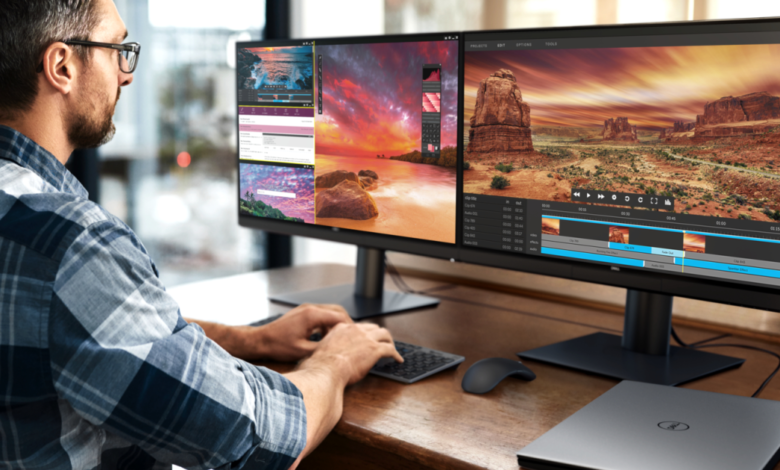
Windows 11 brings a fresh and enhanced user interface, introducing several new features and improvements. One of the exciting features is the ability to configure multiple monitors, allowing users to expand their workspace and boost productivity. In this article, we will guide you through the process of setting up and configuring more than one monitor in Windows 11. So let’s dive in!
Configure More Than One Monitor in Windows 11
Multiple monitors can significantly enhance your computing experience, allowing you to multitask seamlessly, view more content simultaneously, and improve overall workflow efficiency. With Windows 11, setting up multiple monitors is easier than ever before. By following a few simple steps, you’ll be able to extend or duplicate your desktop across multiple screens.
Read more: How to Stop Windows 11’s Automatic Updates
Checking Hardware Compatibility
Before proceeding, it’s important to ensure that your computer and graphics card support multiple monitors. Check your computer’s specifications or consult the manufacturer’s website to verify if it has the necessary ports and capabilities to connect additional monitors. Additionally, ensure you have the cables and adapters for connecting the monitors to your computer.
Connecting Multiple Monitors
To begin configuring multiple monitors in Windows 11, follow these steps:
- Turn off your computer and connect the additional monitors to the available video ports on your graphics card or motherboard.
- Ensure that all the cables are securely connected to both the monitors and your computer.
- Power on your computer and let it boot up.
Adjusting Display Settings
After connecting the monitors, Windows 11 will automatically detect them. To adjust the display settings, follow these steps:
- Right-click on the desktop and select “Display settings” from the context menu.
- In the Display settings window, you will see a representation of your monitors. Click on the monitor you want to customize.
- Adjust the resolution, orientation, and scale settings according to your preferences.
- Repeat the process for each connected monitor.
Configuring Display Modes
Windows 11 offers various display modes to control how content is shown on your monitors. Here are the different display modes and how to configure them:
- Extend: This mode allows you to extend your desktop across multiple monitors, effectively enlarging your workspace. To enable this mode, select “Extend these displays” in the Display settings window.
- Duplicate: The same content is displayed on all connected monitors in this mode. To activate the duplicate mode, select “Duplicate these displays” in the Display settings window.
- Second screen only: This mode disables your primary monitor and only uses the secondary monitor. To enable this mode, press Win + P and select “Second screen only.”
Aligning and Arranging Monitors
Aligning and arranging your monitors correctly can greatly enhance usability. To align and arrange your monitors in Windows 11, follow these steps:
- Go to the Display settings window.
- Click and drag the monitor icons to match their physical placement on your desk.
- If one monitor is positioned above or to the side of the other, drag the monitor icons accordingly to reflect the physical arrangement.
- Click on “Apply” to save the changes.
Customizing Monitor Settings
Windows 11 allows you to customize various monitor settings individually. To customize the settings for a specific monitor, follow these steps:
- Open the Display settings window.
- Click on the monitor you want to customize.
- Adjust settings such as brightness, contrast, and color calibration according to your preferences.
- Repeat the process for each connected monitor.
Calibrating Color and Resolution
To ensure optimal display quality on your monitors, it’s recommended to calibrate color and resolution settings. Windows 11 provides a built-in color calibration tool to assist you in this process. Here’s how to calibrate color and resolution:
- Open the Display settings window.
- Scroll down and click on “Advanced display settings.”
- Under the “Color” section, click on “Color calibration.”
- Follow the on-screen instructions to calibrate the color and resolution settings for each monitor.
Troubleshooting Common Issues
Sometimes, you may encounter issues when configuring multiple monitors in Windows 11. Here are some common problems and their potential solutions:
- Monitor not detected: Ensure all cables are securely connected, try different video ports, or update your graphics card drivers.
- Resolution mismatch: Adjust the resolution settings in the Display settings window to match the native resolution of your monitors.
- Black screen on the secondary monitor: Reboot your computer or update your graphics card drivers to resolve this issue.
- Inconsistent scaling: Make sure the scaling settings are the same for all connected monitors to avoid inconsistencies in text and icons.
Read more: How to Fix Windows 10/11 Black Screen with Cursor
Conclusion
In conclusion, configuring multiple monitors in Windows 11 is a straightforward process that offers numerous benefits in terms of productivity and multitasking. By following the steps outlined in this article, you can unlock the full potential of your multi-monitor setup. Enjoy the expanded workspace and make the most out of your computing experience with Windows 11!
Configuring multiple monitors in Windows 11 opens up a world of possibilities, allowing you to maximize your productivity and multitasking capabilities. By following the steps outlined in this article, you can seamlessly set up and customize your multiple monitor setup. Enjoy the expanded workspace and enhanced computing experience!
FAQs
Can I connect monitors with different resolutions?
You can connect monitors with different resolutions to your Windows 11 computer. However, keep in mind that the overall visual experience might be affected, and you may need to adjust settings to optimize the display on each monitor.
How many monitors can I connect to Windows 11?
Windows 11 supports connecting multiple monitors, and the number of monitors you can connect depends on your computer’s hardware and graphics card capabilities. Most modern systems can handle at least two or three monitors.
Can I use different wallpapers on each monitor?
Yes, Windows 11 allows you to set different wallpapers for each monitor. Open the Display settings window, select the monitor you want to customize and choose the desired wallpaper from your computer or the available options.
What is the recommended display mode for productivity?
The “Extend” display mode is generally recommended for productivity, as it provides a larger workspace spread across multiple monitors. This mode allows you to have different applications and windows open on separate screens, enabling efficient multitasking.
Can I disconnect or reconnect monitors while Windows 11 is running?
Yes, Windows 11 supports hot-plugging monitors, which means you can disconnect or reconnect monitors while the system is running. However, it’s recommended to adjust the display settings after reconnecting to ensure the optimal configuration.











